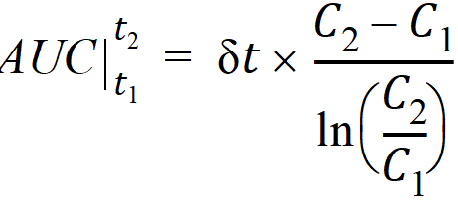The computational formulas for area under the curve calculations are as follows. If the logarithmic trapezoidal rule fails in an interval because C1 <= 0, C2 <= 0, or C1 = C2, then the linear trapezoidal rule will apply for that interval.


where dt is (t2 – t1).


where dt is (t2 – t1).
The computational formulas for interpolating (t1, C1) and (t2, C2) to obtain C* at time t*, for t1 < t* < t2, are as follows. If the logarithmic interpolation rule fails in an interval because C1 <= 0 or C2 <= 0, then the linear interpolation rule will apply for that interval.

Logarithmic interpolation rule

For extrapolation to find C* after the last numeric observation, see the next section.
Additional rules for plasma and urine models
The following additional rules apply for plasma and urine models (not model 220 for Drug Effect, since no extrapolations will be done outside the data range, nor will methods depend on the time of the last positive observation):
If a start or end time falls before the first observation and after the dose time, the corresponding Y value is interpolated between the first data point and C0. C0=0 except in IV bolus models (model 201), where C0 is the estimated dosing time intercept, and except for extravascular and infusion models 200 and 202 at steady state, where C0 is the minimum value between dose time and tau.
If a start or end time falls within the range of the data but does not coincide with an observed data point, then a linear or logarithmic interpolation is done to estimate the corresponding Y, according to the AUC Calculation method selected in the NCA Options tab. Note that logarithmic interpolation is overridden by linear interpolation in the case of a non-positive endpoint.
If a start or end time occurs after the last numeric observation (i.e., not “missing” or “BQL”) and Lambda Z is estimable, Lambda Z is used to estimate the corresponding Y:
Y = exp(Lambda_z_intercept – Lambda_z(t))
= [exp(Lambda_z_intercept – Lambda_z(tlast))]
[exp(–Lambda_z(t – tlast))]
= (predictedConcAtTlast)exp(–Lambda_z(t – tlast))
The values Lambda_z_intercept and Lambda_z are those values found during the regression for Lambda Z. Note that a last observation of zero will be used for linear interpolation, i.e., this rule does not apply prior to a last observation of zero.
If a start or end time falls after the last numeric observation and Lambda Z is not estimable, the partial area will not be calculated.
If both the start and end time for a partial area fall at or after the last positive observation, then the log trapezoidal rule will be used. However, if any intervals used in computing the partial area have non-positive endpoints or equal endpoints (for example, there is an observation of zero that is used in computing the partial area), then the linear trapezoidal rule will override the log trapezoidal rule.
If the start time for a partial area is before the last numeric observation and the end time is after the last numeric observation, then the log trapezoidal rule will be used for the area from the last observation time to the end time of the partial area. However, if the last observation is non-positive or is equal to the extrapolated value for the end time of the partial area, then the linear trapezoidal rule will override the log trapezoidal rule.
The end time for the partial area must be greater than the start time. Both the start and end time for the partial area must be at or after the dosing time.